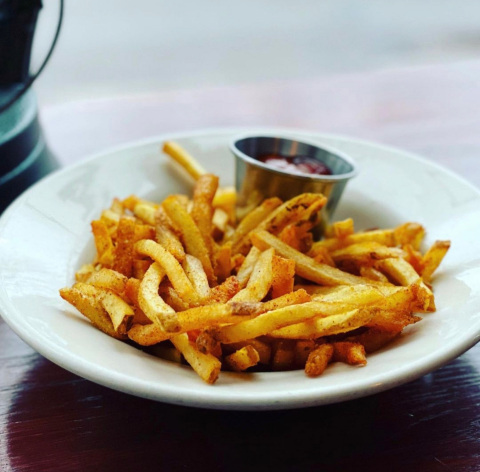ROCHESTER, N.Y.--(BUSINESS WIRE)--Today, the French fry. Tomorrow, the global food supply chain. Farther Farms is a high-growth food technology start-up working to solve one of society’s greatest challenges: how to make food go farther. The company began with one of consumers’ favorite foods, creating the world’s first commercially-available shelf-stable, fresh-cut style French fry that’s never-frozen and ready-to-cook. Made with Farther Farms’ sustainable, carbon dioxide (CO2)-based technology, the French fries have a 90-day shelf life at room temperature – no artificial preservatives added, and no freezing or refrigeration required.
“By reducing dependency on the cold chain, we are leapfrogging a major limitation and creating new global opportunities,” said Vipul Saran, co-founder and chief technology officer, Farther Farms. “The sustainable, CO2-based technology we’ve developed at Farther Farms is already taking French fries farther than they’ve ever gone before – and we’re gearing up to do the same for foods across the spectrum.”
Shelf-stable French fries are only the start for Farther Farms. Their revolutionary food pasteurization technology creates an entirely new category of packaged foods that unlock new markets and opportunities along the entire supply chain. The company’s technology uses CO2 at high pressures and moderate temperatures (“supercritical CO2”) as a key working fluid for pasteurization. Compared to the traditional use of high temperature steam or water, pasteurization using supercritical CO2 protects the food’s integrity and nutritional value, ensures food safety, and extends shelf-life without the need for additional preservatives. The technology can work on many types of ready-to-eat and ready-to-cook foods, including fruits and vegetables, dairy, and meat and plant-based meat alternatives.
Wide adoption of the technology could help stabilize the global food supply chain by reducing reliance on freezing and refrigeration. In developing countries like India, where millions of farmers live in poverty, $13 billion of food is wasted each year due to gaps in the cold chain.i Domestically, as much as 40% of greenhouse gas (GHG) emissions on refrigerated trucks come from maintaining frozen temperatures – bypassing the cold chain with Farther Farms’ technology has potential to significantly reduce GHG and support a greener future.ii
“Food processing technologies have the power to transform the food system, yet we have not had a system-level breakthrough since Clarence Birdseye first invented freezing technology in the 1920s. Our CO2-based technology has the potential to change that,” said Mike Annunziata, co-founder and chief executive officer, Farther Farms. “As we grow our product portfolio of viable alternatives to frozen foods, we can reduce the need for expensive capital investment in the cold chain without sacrificing convenience and quality.”
Annunziata explained that just as the adoption of cell phones in developing markets obviated the need for landline infrastructure, the technology and products from Farther Farms would do the same for the food cold chain.
For restaurants and foodservice operations, the ability to move fries and other foods out of costly cold storage creates money-saving and money-earning opportunities. Freezer and refrigerator real estate can go to higher-value, higher-margin foods such as appetizers, desserts and specialty breads. In an industry operating on thin margins, Farther Farms’ shelf-stable fries hold broad appeal. Wholesome and delicious, the fries can stay crispier up to 40 minutes longer than the average fry, perfect for restaurants and venues gearing up for summer. Here is what a few industry stakeholders have to say:
- “There is significant business value in moving more foods out of the fridge and freezer, but restaurants will only make those moves if the product delivers the quality and taste customers crave. When you open a bag of Farther Farms French fries, it smells like a fresh potato should, and the product retains the crispiness you expect from a hot, fresh-cut fry.” – Zach Koff, chief operating officer, Shake Shack and early investor, Farther Farms
- “At scale, this innovation will completely change the processed potato space. I’ve sold billions of pounds of French fries in my career and from what I’ve seen, the demand for this product in new and existing markets will be hundreds of millions of pounds within five years, if not billions.” – Richard Porter, former president, Lamb Weston and board member, Farther Farms
- “I have been selling French fries for over 20 years, and the engagement and interest level in this product from my customers has been off the charts.” – John Hanna, president, Endico Potatoes in NYC, a distributor of Farther Farms’ product
- “[Switching to Farther Farms fries] was a no brainer! To be able to find a product that not only is superior in taste, quality and crispiness but is also good for the environment is rarely found. We hit a home run [with these] fries.” - Max Gordon, owner, The Hideaway, a local Rochester restaurant currently selling Farther Farms’ product
With over $10MM in funding raised to date, and the initial success of its technology and pilot facility, Farther Farms’ path to making the biggest impact – on farmers, the foodservice industry and the food system at large – now shifts to scaling its French fry production capacity. The company is well positioned to scale up, with a team of more than 25 full-time employees grounded in food science, microbiology, engineering, finance and foodservice. Farther Farms developed its technology at Cornell University, a leading food science institution, and the company has benefitted from an impressive slate of advisors and investors from instantly recognizable names such as Shake Shack, SpaceX and Venetian Hotels, as well as experts in agriculture, engineering and food processing. With growing interest from stakeholders, the potential to bring resilient and sustainable food systems to scale is limitless.
i Maheshwar, C., & Chanakwa, T. S. (2006). Postharvest losses due to gaps in cold chain in India-A solution. Acta Hortic, 712, 777–784. https://doi.org/10.17660/ActaHortic.2006.712.100
ii Stellingwerf, H. M., Kannellopoulos, A., van der Vorst, J. G. A. J., & Bloemhof, J. M. (2018). Reducing CO2 emissions in temperature-controlled road transportation using the LDVRP model. Transportation Research Part D: Transportation and Environment, 58, 80–93. https://doi.org/10.1016/j.trd.2017.11.008




